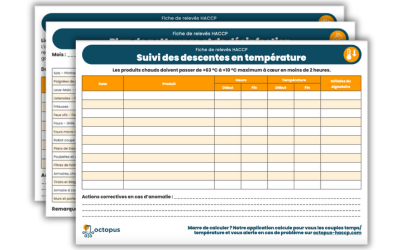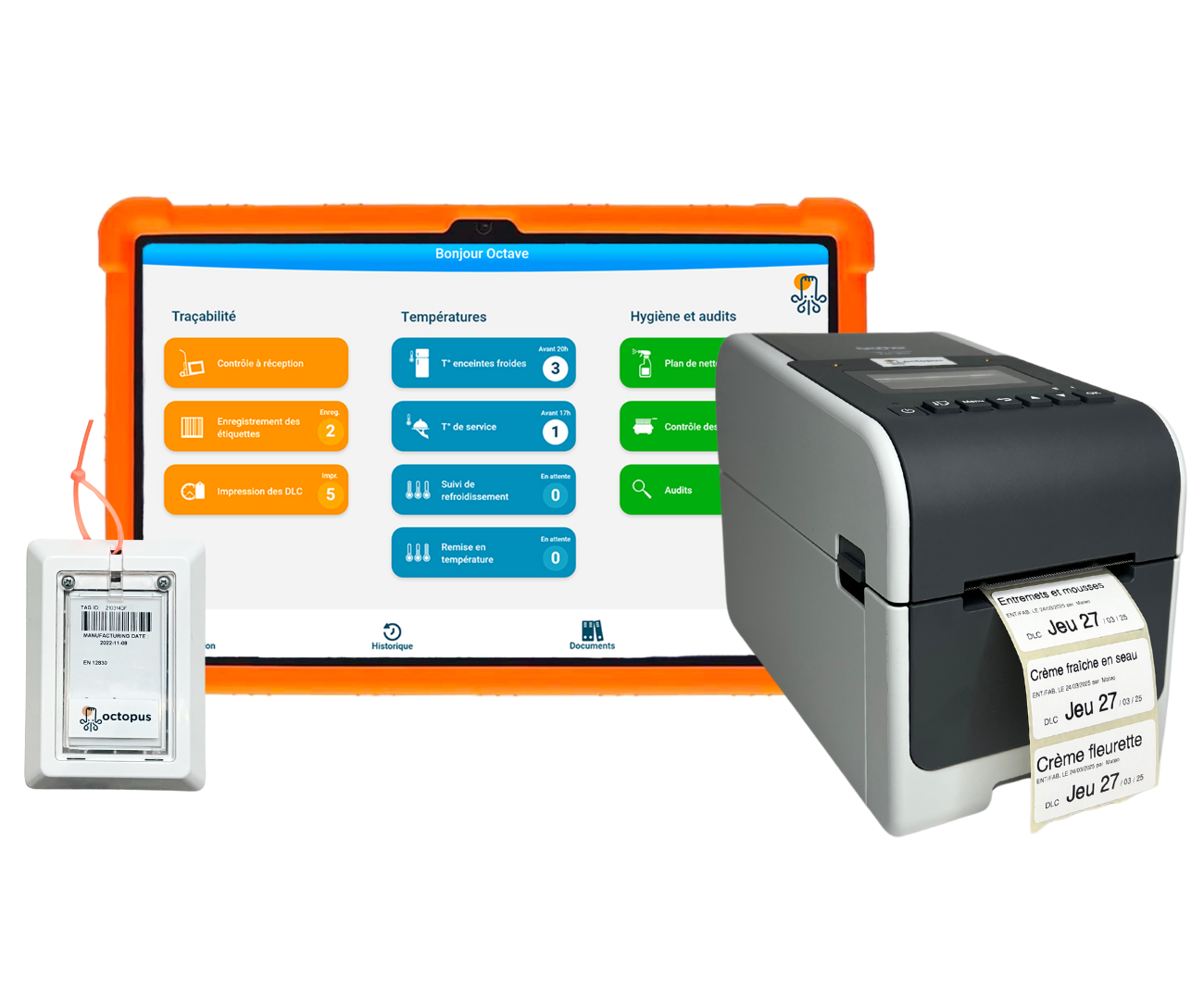Fiche de température de cellule de refroidissement rapide
Température
⏳ Temps de lecture : 5 min
🗓 Mis à jour le : 25/08/2024
Sommaire
- Quand faut-il refroidir rapidement les aliments dans un restaurant ?
- En quoi consiste la fiche de réception de marchandise ?
- Ce que dit la réglementation à propos du refroidissement rapide
- Combien de temps conserver les fiches de contrôle de réception de marchandise ?
- Quels sont les dispositifs pour le refroidissement rapide en restauration ?
- Simplifiez la saisie de la fiche de contrôle de réception de marchandise
- Traçabilité des opérations de refroidissement rapide en restauration
En restauration comme dans les autres métiers de bouche 🍖, la gestion des denrées alimentaires est particulièrement encadrée pour écarter tout risque sanitaire et savoir comment réagir en cas d’anomalie détectée.
On ne prend pas de risque avec la santé des clients ! 🐙
C’est la raison pour laquelle les professionnels du secteur alimentaire ont l’obligation de mettre en place, d’appliquer et de maintenir des procédures fondées sur la méthode HACCP. 🧼️
Le refroidissement rapide des aliments fait partie des points critiques ⚠️ (CCP) identifiés à travers cette méthode. Nous entendons le refroidissement 🧊 rapide comme la méthode pour réduire la température rapidement pour éviter que les bactéries 🦠 ne se développent.
Il nécessite une maîtrise particulière, et chaque opération doit être mentionnée sur une fiche 📑 de température de cellule de refroidissement rapide format papier, ou via une application comme Octopus HACCP 📳 . Nous vous proposons de faire le point sur les opérations de refroidissement rapide dans cet article.
Ce que dit la réglementation à propos du refroidissement rapide ⏳
Quel est le protocole HACCP à respecter ? ✅
Gardez la tête froide car… Il n’y a pas de méthode imposée par la réglementation HACCP cuisine pour le refroidissement rapide des denrées 🍖, si ce n’est qu’il ne peut pas se faire à l’air libre. Que vous ayez une cellule de refroidissement rapide ou non, ce qui compte c’est le résultat et surtout le respect du couple temps/température qui conditionne l’intégrité bactériologique des aliments. 🥩
Le saviez-vous ?💡 La méthode de refroidissement rapide que vous utilisez doit garantir le passage de 63 °C à 10 °C en moins de 2 heures, après quoi l’aliment est stocké dans une enceinte froide à 3 °C maximum.
Le délai de 2 heures maximum pour atteindre la température à cœur de 10 °C n’est à considérer que si la température de la denrée alimentaire est de 63 °C.
Par exemple 📝 : Si la température de départ est de 80 °C, le décompte ne débutera pas immédiatement. Cette règle tient simplement au fait que la zone de température la plus favorable au développement de bactéries dangereuses, à l’origine d’intoxications alimentaires sévères, se situe entre 63 °C et 10 °C.
Quand faut-il refroidir rapidement les aliments dans un restaurant ? 🧊
Le recours au refroidissement rapide ne concerne pas uniquement les grosses cuisines collectives : tous les établissements de restauration concernés, dès qu’un plat passe du chaud au froid. Et chaque fois que c’est le cas, il faut assurer la traçabilité de cette étape via une fiche de température.
Voici les situations les plus courantes où le refroidissement rapide est indispensable :
🥘 Les plats cuits à l’avance pour un service différé
Si un aliment est préparé en avance pour être consommé plus tard, le refroidissement rapide est nécessaire dès qu’il n’est pas servi immédiatement après cuisson. Cela permet d’éviter que le produit reste trop longtemps dans la zone de danger (entre 63 °C et 10 °C).
❄️ Les préparations destinées à être surgelées
Avant de passer au surgélateur, un plat chaud doit d’abord être refroidi rapidement, car la surgélation ne compense pas une température excessive à cœur. Si vous mettez une préparation encore chaude au congélateur, non seulement vous ralentissez la surgélation, mais en plus, vous risquez de favoriser le développement bactérien au cœur de l’aliment. Vous risquez aussi d’endommager votre congélateur puisque celui-ci devra dépenser beaucoup d’énergie pour refroidir vos denrées encore chaudes.
🍰 Les desserts et pâtisseries à base de produits sensibles
Dès qu’il y a des œufs, du lait ou de la crème, on ne prend pas de risques. Et même pour les préparations sans cuisson comme certaines ganaches ou inserts, un refroidissement permet une meilleure conservation et une diminution des dangers.
🧑🏫 Les plats témoins en restauration collective
Dans les cantines, hôpitaux, maisons de retraite ou autres structures collectives, il est obligatoire de conserver un plat témoin pendant 5 jours à 3 °C maximum, pour pouvoir l’analyser en cas de suspicion d’intoxication alimentaire. Nous vous avons rédigé un guide complet concernant les plats témoins et les bonnes pratiques à respecter.
Quelles informations sont à conserver pour le refroidissement rapide ?
La méthode HACCP prévoit le relevé de plusieurs informations sur la fiche 📃 de température de cellule de refroidissement rapide :
- La date 📆 ;
- Le nom du produit 🥦 (préparation ou aliment) ;
- L’heure de début de l’opération 🕥 et l’heure de fin ;
- La température à cœur 🌡 de début et de fin.
L’opérateur qui remplit la fiche de température de cellule de refroidissement rapide doit s’identifier avec ses initiales, et en cas d’anomalie, il doit noter les actions correctives ✅ qu’il aura prises en conformité avec le protocole HACCP en vigueur dans le restaurant. En général, si le couple temps/température est dépassé, l’aliment doit être jeté 🗑, sauf dérogation liée à votre plan de maîtrise sanitaire.
Quels sont les dispositifs pour le refroidissement rapide en restauration ?🍴
En matière de refroidissement rapide ce qui compte, c’est l’efficacité. Peu importe la méthode choisie, elle doit permettre de faire chuter la température à cœur des aliments de 63 °C à 10 °C en moins de 2 heures.
🧊 La cellule de refroidissement rapide
Elle permet un refroidissement uniforme, rapide et contrôlé de vos préparations, qu’il s’agisse de plats complets, de sauces, de pâtisseries ou même de grandes quantités de denrées.
Elle fonctionne grâce à un système de ventilation d’air froid très puissant, qui évite la stagnation de chaleur au cœur du produit.
💧 Les méthodes alternatives
Si vous n’avez pas encore investi dans une cellule, pas de panique. Il existe d’autres moyens pour refroidir rapidement vos aliments.
- Le refroidissement sous l’eau froide courante
Idéal pour des aliments comme des pâtes, du riz ou des légumes cuits à l’eau. On les place dans un bac perforé ou une passoire et on laisse couler un filet d’eau froide en continu. - Le refroidissement en bac sur lit de glaçons
Vous placez votre plat ou récipient dans un second bac rempli d’eau et de glaçons. L’eau froide enveloppe mieux le contenant que l’air, donc le refroidissement est plus rapide. - Le refroidissement en poche sous vide sur lit de glaçons ou sous un jet d’eau froide
Cette méthode est utilisée surtout pour les aliments sous vide.
Quelle que soit la méthode utilisée pour le refroidissement des denrées alimentaires, il faut remplir une fiche de température de cellule de refroidissement rapide.
C’est contraignant mais c’est obligatoire ! ⚠️
Traçabilité des opérations de refroidissement rapide en restauration 🔍
Pour être conforme avec la démarche HACCP et pouvoir produire les documents utiles en cas d’audit ou de contrôle sanitaire, il est nécessaire de remplir une fiche de température de cellule de refroidissement rapide ❄️. Cette opération peut se faire sur papier en téléchargeant ci-dessous notre fiche de température de cellule de refroidissement rapide à compléter, soit en digitalisant vos relevés avec Octopus HACCP. 📳
Cette solution nomade pour tablette et mobile, compatible iOS (Apple) et Android 📳, intègre une fonctionnalité de suivi de refroidissement rapide directement accessible depuis l’écran d’accueil.
La navigation se fait de manière intuitive et pratique en tenant compte des conditions dans lesquelles les opérateurs saisissent les informations 🤳. Une fois les données renseignées sur votre fiche numérique de température de cellule de refroidissement rapide, rubrique « Départ de refroidissement » et « Fin de refroidissement », toutes les données sont archivées 📃 et rapidement accessibles si besoin.
FAQ 💡
Quelle est la température d’une cellule de refroidissement ?
Une cellule de refroidissement rapide est conçue pour descendre rapidement la température à cœur des denrées alimentaires de 63 °C à 10 °C. Le point de départ peut être supérieur, avec des températures à cœur à 80 ou 90 °C. Les cellules de refroidissement rapide sont des machines conçues pour abaisser rapidement la température des aliments, de sorte qu’ils passent d’une température après cuisson, en général autour de 70°C à 80°C à une température de refroidissement de +3 °C le plus rapidement possible, pour empêcher le développement bactérien. Il est conseillé de ne pas mettre les préparations trop chaudes (supérieur à 70°C) dans vos cellules de refroidissement, pour ne pas fatiguer les moteurs.
Quelle est la règle du refroidissement rapide ?
La règle du refroidissement rapide selon la méthode HACCP consiste à respecter le couple temps/température à cœur. Le refroidissement rapide doit descendre la température de l’aliment de 63 °C à 10 °C en moins de 2 heures.




